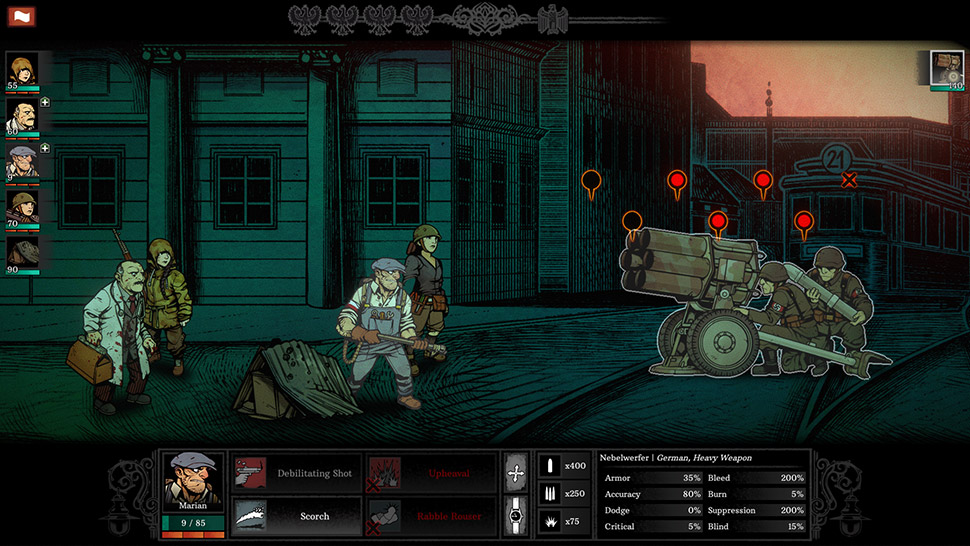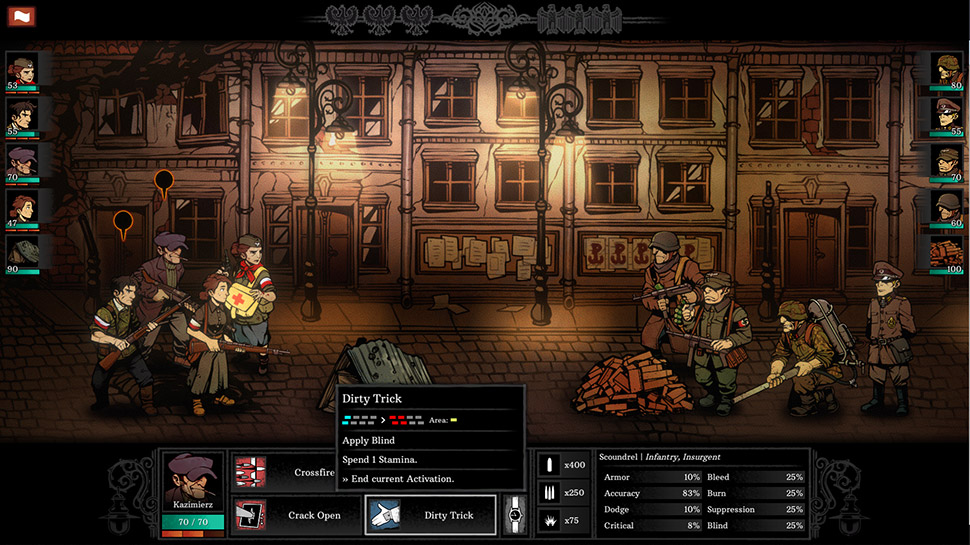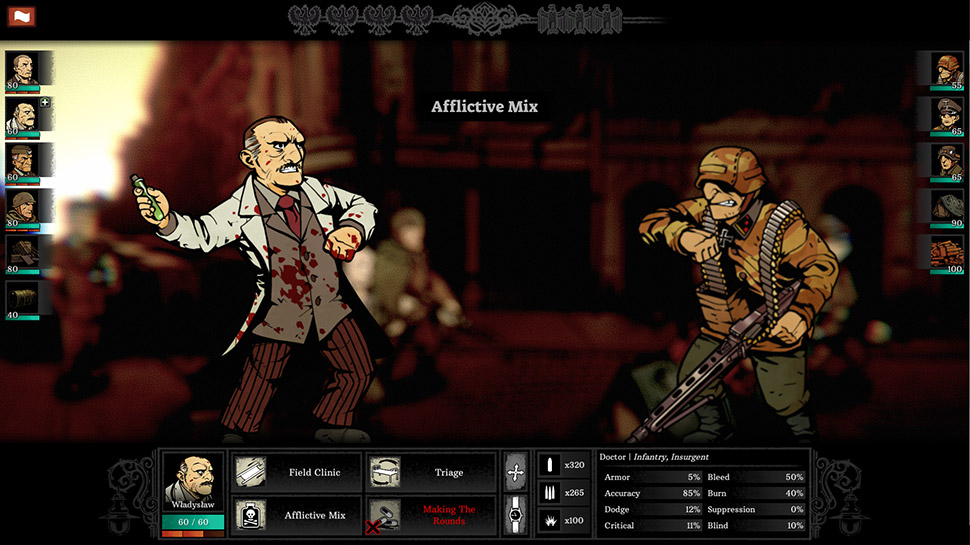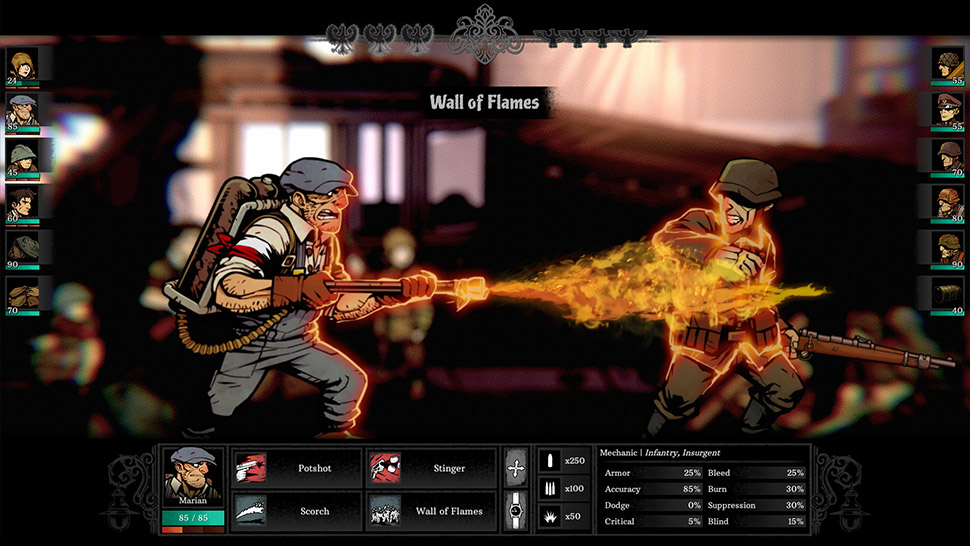WARSAW Review

 By Marcus Jones | Oct 2, 2019
By Marcus Jones | Oct 2, 2019
WARSAW is set during a dark and tumultuous time in our world's history - 1944 in Poland. Generally, there'd be more to discuss in regards to the game I'm about to describe, but I believe this sums up this dark game based on factual history that occurred within Poland. You're a resistance member trying to push back the Nazi occupation of Warsaw using every tactic possible.
The game starts with a short, but an excellent tutorial that I recommend everyone take the time to play through. It helps gear you up for the challenges of the game, and it does an excellent job of explaining several pieces. I went through it twice, which certainly helped as a refresher for some of the bits I got confused about the further in the game I went. It was well worth the extra time.

The game will initially place you on the "world map." This map represents one of the sectors of Warsaw. The areas of Warsaw you'll visit are large and sprawling, filled with random enemy encounters, chance events, and random loot spots on top of your objective. Moving around is simple, using the left mouse button (LMB) or arrow keys to move your tiny squad around the tight corners. It's possible to maneuver around enemy patrols, but watch out for your ability points (AP). You start every mission with 100 AP, and if it drops to 0, you fail the mission. This makes it a requirement to manage your resources, AP, and inventory as you move about the map. Upon completing a mission, you'll gain whatever rewards were listed for it, on top of all the loot you managed to acquire.
Additionally, time will progress based on the mission screen; things occur between your time in the field and returning to the hideout. You'll end up handling a small, randomized event that'll dictate an outcome before seeing how your war efforts have impacted the momentum of the resistance. Just as an example, after the tutorial alone, I had two separate events occur. One gave me a bonus set of ammunition, and the other caused a more substantial impact on my resistance efforts. It provides excellent replayability, knowing not only will my missions and mission areas will change, but also that events are randomized.

Combat is an intriguing mix of turn-based strategy and lane-based combat. Both sides have two lanes (upper and lower) and four slots each. This gives your side of the battlefield eight spots where characters and obstacles set up shop. This structure is the core of the combat system. As characters can move locations, attack based on what spots their skills allow, and sometimes require. Combat, as I mentioned, is turn-based. Every member of your party and the enemy party is granted an action each turn. The game then does one action from each, before the next turn starts. It's possible to use all of your actions with a single character until their stamina runs out (everyone starts with three stamina bars).
Attacking uses ammunition, which a character's skill will explain to you in the bottom part of the menu. Much like other tactical strategy games, you're giving a full list of details regarding your attack. This includes the accuracy to hit, potential damage, ammo cost, what setup is required to actually carry out the attack, etc. And much like the X-COM series, expect to miss consistently even with a 95% accuracy rating. I think I missed more shots than I took; however, that is possible. I'm not saying I expect to be a proficient killer given these are randomly recruited soldiers and civilians taking on a well-equipped and well-trained fighting force, but I was shocked a few times at just how much I missed. Providing an additional set of challenges for combat are the obstacles and status effects. Barriers can absorb some damage until they eventually break, and status effects can be applied depending on the attack or ammo used. Effects like suppression will prevent you from using skills or attacking, while bleed and fire damage will continue to impact you over time. These statuses can also stack, meaning it's possible to have multiple effects in play simultaneously. It sucks to watch your health drain quickly because of the effects at the end of a turn.

Between combat and missions, you'll spend some time at your hideout. Here you're able to review your party members (both the unique ones and randomly recruited civilians), check on supplies and different sectors of Warsaw, remember the fallen, or start up your next underground efforts. The game revolves around supplies, which are earned from keeping control of various areas of Warsaw or through missions. While at the hideout, these supplies are used to recruit various members, buy/trade/repair equipment and ammunition, or provide assistance to beleaguered boroughs of the city. You'll also end up having opportunities to recruit new soldiers to your outfit, helping to flesh out your capabilities as you take on the Nazi occupation forces. Your units will also level up from commendations, unlocking new abilities as they get through the three levels.

The game isn't procedurally generated, but the randomized events are a blessing, in my opinion. Missions will change between restarts, skills can be rearranged, and the civilians, already randomized, will vary from game to game. As I mentioned, this replayability is one of the best parts of the game on top of the challenging combat and story/setting. The bow on top is the eye-catching, hand-painted art that really makes things pop. Detailed sprites and environments are both bright and colorful, yet dreary and telling of the factual backdrop of this game. Attacks are brutally depicted and without even being outwardly gory, still managed to present the visceral nature of what you're doing. It's not Wolfenstein in terms of the over the top antics and depiction, but it's still impactful.
Simply Put
WARSAW is a solid tactical strategy role-playing game. It suffers from some of the same antics that drive me crazy in other games in the genre, with a bizarre way of calculating hit ratios. The randomized events and absolutely stunning graphical depiction of the game more than makeup for it. For those doubly interested in World War 2 and tactical strategy, this is a great title to look into.
Note: WARSAW was reviewed on PC. A digital copy of the game was provided by the publisher/developer.




